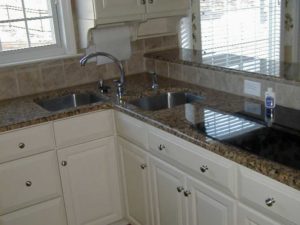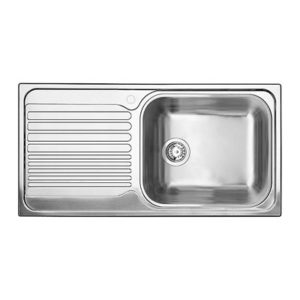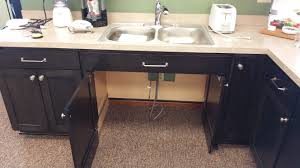Read Part 1 of this series
Read Part 2 of this series
Read Part 3 of this series
Choosing the Style of Your Sink
When determining the style of your sink, you need to think about the décor of your kitchen as well as how you cook in it. Gourmet chefs or keen bakers may have different requirements from each other and from the average home-owner. The following are features that you’ll need to think about and choose between:
Farmhouse
Many farmhouse sinks are large single basins but they’re also available in double format too. What sets them apart is that they have a distinctive front wall, called an apron, which has a vintage vibe many homeowners love. A farmhouse sink makes a deliberate design statement and can be the focal point of your kitchen. They are available in many different finishes like traditional porcelain over cast-iron, stone composite and even in more contemporary stainless-steel versions.
For the not-so-tall among us and for kids, a farmhouse sink can be more comfortable to use because the basin is set closer to the front of the countertop. However, this style with it’s deep basin may not be accessible to someone in a wheelchair as they won’t allow enough leg clearance underneath.
Corner Sink
Corners are not ideal locations for sinks due to the large gaping expanse of useless countertop that is often created behind the sink into the corner, but sometimes it just can’t be helped. If you find yourself in this situation you’ll have a more limited selection of sinks but should be able to find a few in each material and with a small choice of sizes.
Built-in drainboard
Available with single or double sinks these integrated drain-boards work wonderfully, and double as a great place to dry fruits and vegetables after washing. They can eat up a lot of counter space, so you’ll need a large kitchen to really appreciate them. TIP: In Canada, these are very difficult to find as under-mounts but if you look hard enough they are out there.
Under-mount vs Drop-in
Drop-In: Also known as self-rimming or top-mount sinks all have a visible lip around the perimeter that rests flat on the countertop. This lip however, can trap food bits and if not sealed properly can leak water. They can be less expensive than under-mounts to buy and to install and much easier for people who like to d.i.y.
Under-mount: As the name indicates, this sink installs from below the counter. It does have a rim, but it isn’t visible and it attaches to the underside of the countertop. Being rimless makes it easier to clean the surrounding countertop. This style really emphasizes a beautiful stone or stone composite countertop but can’t be used with laminate countertops. They can be more expensive to buy and install as the countertop needs to be cut-out and finished more precisely, but they add a more refined look to a kitchen or even bathroom.
Round or square corners?
Do square corners and sides take longer to clean than rounded corners? This will depend on how often you use your sink and what you use it for. And perhaps whether you have a housekeeper or not! The radius of the corners can really influence how modern or traditional the sink looks.
There are usually 3 corner radius styles:
#1) Rounded. Many homeowners consider curved corners easier to clean than one with square corners. This style is a more traditional or standard look.
#2) Semi-rounded or gently curved. This style is the best of both worlds and it should give you easier to clean corners with a more modern look.
#3) Square. These 90 degree corners also known as zero radius, offer crisp modern style for a sleek minimalist look.
Sink Accessibility
- Roll-under sink. A roll-under space should be at least 30 in/75cm wide x 27 in/68cm high. Anything less than 27in/68cm high poses a scalding hazard to the knees of people who use wheelchairs. TIP: The base of the sink and the pipes underneath should be insulated to prevent burns.
- Make it height adjustable. Make it work for everybody and set the sink in a section of countertop that can range in height between 28in/71cm and 36in/91cm.
- Depth of basin. Modern popular deep basins can be uncomfortable to use for shorter or seated people as well as being a strain on the backs of tall people. Aim for the shallowest sink(s) you can. ADA (American disabilities act) requirements for accessible basin depths are no more than 5-6.5in/13-16cm deep.
- Clear approach space. A clear floor-space area of 30in/76cm x 48in/122cm is required directly in front of the sink for a wheelchair to manoeuver comfortably and easily.
- Contrasting sink color. Make it easier for people with low vision to see the where the edge of the sink is by contrasting it with the countertop color.
- Good task lighting. Ensure you have appropriate lighting for this area so you can see better which increases safety.
- Single faucet. You’ll need a single-lever faucet to complete the accessibility of your kitchen sink.
Cabinet size determines sink size
Before you can select a sink you’ll need to know the size of the base cabinet. This cabinet needs to be large enough to accommodate the sink you choose, as well as being strong enough to support one of the heavier materials such as cast iron, if that’s the route you go. Manufacturers will indicate the size of cabinet that each sink requires in the specifications.
Action Plan
As sinks are the central hub of your kitchen be practical when choosing one and don’t let pure trend sway your decision.
Choosing the best kitchen sink for your needs requires you to consider several things such as décor style, maintenance requirements, personal preference of material, accessibility needs, cooking style, kitchen size etc.
Have a kitchen plan drawn up and take it and a small file of style ideas with you when you start shopping. This smart move will save you and the showroom salesperson time as you’ll quickly be able to narrow down your choices and you’ll end up with the best sink for you.




